Warning: This infobox has missing parameters: designation, class, diet, subspecies, habitat and unrecognized parameters: members, imageBG
- "Those Tuskens walk like men, but they're vicious, mindless monsters."
- ―Cliegg Lars
Tusken Raiders, less formally referred to as Sand People or simply as Tuskens, were a culture of nomadic, primitive sentients indigenous to Tatooine, where they were often hostile to local settlers. The term Sand People was given to them due to their existence in the desert, and was in use from at least around 4,000 BBY; but the more formal name of Tusken Raiders was acquired much later, due to a period of concerted attacks on the settlement at Fort Tusken in 98-95 BBY. Although this name is often used as a common term for the race, it actually refers only to the partipants of the attack on the settlement.
Specialists studying the past of the Tusken Raiders also used the term Ghorfa to denote an earlier sedentary phase of their culture, and lastly Kumumgah, for the earliest stratum of sentient civilization on the planet, believed by some to represent a common ancestry shared by the Ghorfa and the Jawas. In the culture of the Tuskens, to expose any part of the flesh was forbidden and seen as a disgrace.
Biology and appearance
A Tusken Raider male
- "They're like animals, and I slaughtered them like animals. I hate them!"
- ―Anakin Skywalker, on his massacre of a camp of Tusken Raiders after the death of his mother, Shmi
It was stated by A'Sharad Hett, while on a mission to Aargonar with Anakin Skywalker, that Tusken Raiders were biologically incompatible with Humans. This implies that Tusken Raiders comprised a non-Human species.
Sand People were known to adopt settler orphans, such as K'Sheek, after raids on Human settlements and convoys, in a similar fashion to Mandalorians. Also, the Jedi Knight Sharad Hett won a place in their tribes through his great combat prowess. Beyond these isolated and uncommon incidents, there is no indication that Humans were present in any great number amongst the Tuskens.
Scientific studies of the few corpses found were said to have been inconclusive, and while in part, the lack of detailed knowledge can be accounted for by the hostility of the Tatooine climate, and in part, by the hostility of the Tusken Raiders themselves, it should be borne in mind that knowledge of the Sand People—or what was thought to be known about them—was very often based on uncertain and inferential evidence. However, A'Sharad Hett's claim that he learned of the Tusken-Human incompatibility, combined with his first-hand knowledge of the Tuskens, is compelling evidence that they were a different species.
It is thought that Tuskens and Jawas shared common ancestry in the Kumumgah, who were taken off world by the Infinite Empire to work as slaves on other planets. In fact, the Sand People were one of the slave races used in construction of the Star Forge by the Ratakans. Since the Kumumgah were considered a possible origin species for Humanity, it is possible that Tuskens and Humans shared ancestry; however, the connection was not close enough to allow inter-breeding, and their unmasked appearance was distinctive. Anakin Skywalker recognized immediately that the unmasked A'Sharad Hett was not genetically a Tusken Raider; this indicates that he was familiar with the appearance of Tuskens under their masks. Later, Skywalker had a nightmare in which a Tusken appeared partially unmasked; however, it is not known whether this appearance represented their true form or was simply a "boogeyman", derived from Anakin's imagination.
Society and culture
The desert life

A Tusken Raider wielding a gaderffii, or Gaffi Stick
- "On Tatooine, the very air and sunlight are one's enemies."
- ―Sharad Hett
Tusken culture was defined first and foremost by the climatic extremes of Tatooine: barren wastes stretching for days' journey on end, scoured by harsh, arid winds and searing heat by day; icy, deadly stillness after dark.
Practical survival was the first priority in terrain like this, and to protect themselves, the Sand People learned early in their existence to cover themselves from head to foot in desert-colored rags and robes, leaving no bare skin exposed to the elements. It is perhaps no surprise that these outward trappings came to be the most basic tokens of Tusken Raiders identity—their mode of dress was, after all, a direct expression of their way of life.
Oral tradition was a large part of Tusken culture, so much so that Storytellers were considered the most important members of a tribe. On the other hand, written communication was believed to cheapen the value of Tusken history, and was therefore shunned. In each tribe, a small number of individuals would be trained from birth to become Storytellers, learning the tales of their ancestry with perfect accuracy. There was only one accepted history across the many Tusken tribes, and if someone questioned or spoke even a single word of the histories incorrectly, it was considered a blasphemy punishable by death. Thus, Tusken history was passed down orally from generation to generation with almost no alterations in the material. If the Storyteller of a tribe died before the training of their apprentice was complete, the tribe was considered to be unworthy of existence and would quickly destroy itself through infighting. In rare circumstances, those that proved themselves worthy, such as great warriors, were also permitted to listen to the teachings of the Storyteller.[1]
The Tuskens were divided into small tribes or clans, and roamed widely across the desert surface of Tatooine, but the focus of their habitation-patterns seems to have been the Jundland Wastes, the one major area of rocky upland that rose clear of the shifting sands: in particular, the traditional sandstorm-season encampments of many clans were concentrated area known as the The Needles. Occasionaly the different clans would go to war over territory and would even unite under a powerful warlord. They raided widely through both the Jundland Wastes and the Dune Sea, however, and any creatures, particularly offworlders, were subject to their savage attacks. Traveling on trained banthas, raiding parties would swiftly appear from the desert, riding in single file to conceal their numbers, and then disappear back into the cover of the dunes with trophies and prisoners. Due to their lack of advanced technology, their primitive society and viciousness, they were considered barbaric monsters by most of the galactic populace.
Although Tusken garb varied from tribe to tribe, certain aspects of dress remained constant. The eyes of Sand People were covered with goggles or visors which shielded them from the harsh sunlight. Below the eyes two pipes protruded from the mask, most likely to facilitate breathing. A constantly open mouthpiece covered the area between the nose and jaw, while a moisture trap worn around the neck humidified the air taken into the lungs. Sand People were also recognizable by their fierce gaderffii weapons. The gaderffii was so integral to their culture that Tuskens would often commit ritual suicide in the event that an injury made them unable to properly wield the weapon.[2] While rejecting most examples of modern technology, long-barreled Tusken Cycler rifles and stoves made of scavenged or stolen metal were not uncommon.
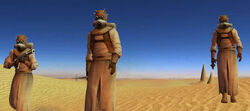
Common Tusken garb during the time of the Jedi Civil War.
Female Tuskens wore variations upon the male Tusken garb (though in some tribes, males and females wore the same), often incorporating womp rat tusks into their attire: in some tribes, their role seem to have involved maintaining the encampments while the males raided and hunted, but in other groups, perhaps more strictly nomadic in outlook, they may have lived and hunted more closely alongside their menfolk. Tusken children wore unisex masks; gender-specific coverings were not allowed until after they became adults.
Tuskens were forbidden to take off their protective clothing in front of others, except in a few very specific circumstances: at childbirth, on their wedding night and during coming-of-age rituals (two events which were often one and the same), and as adults, only in the privacy of their tents with their blood-bound mates. Breaking this rule meant either banishment or death, depending on the specific tribe rules.
The emphasis on outward appearance and concealment of physical form also enabled—and disguised—one of the most striking elements of Tusken culture: although the Sand People were regarded as alien savages by Tatooine's Human colonists, an unknown proportion of the Tusken population were, at least by the last decades of the Galactic Republic, every bit as Human as the settlers themselves.
One tribe near Mos Espa had burial grounds and was led by a War Chief. The tribe abducted Sabé (in the guise of Queen Amidala, but the War Chief was defeated by the Jedi Padawan Obi-Wan Kenobi.[3]
Social organization
- "It's the misguided traveler who tempts the Tuskens' hospitality."
- ―Obi-Wan Kenobi to Luke Skywalker
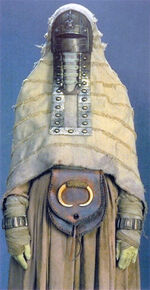
A female Tusken Raider.
Sand People organized into clans and tribes, the former being kin-groups of between 20 to 30 beings, and the latter being larger affinities with no strict bounds. In a typical tribe, the adult males typically assumed the role of hunter and protector, often leaving their camps for an extended period of time. Females, often accompanied by massiff guard animals, cared for the children, known as uli-ah, and the seasonal camps. After completing the rites of adulthood at the age of fifteen, the uli-ah were granted full status within the tribe and paired for marriage in a ceremony involving blood exchanges between the male, female and their banthas.
The bantha was another vital element of Tusken culture, a large, shaggy-coated quadruped capable of surviving for long stretches in the harsh terrain of the deserts; some banthas roamed wild, but the Sand People had learned to domesticate them. Every Tusken had their own mount from childhood, and they rode bantha-back for journeys of any length: small scouting parties of two or three mounts, or entire clan communities on seasonal migrations, they traveled through the dunes and rock-formations on the shoulders of their mounts, in single line.
Tuskens subsisted primarily on hubba gourds, and moisture farmers took great humor in the fact that they became intoxicated on just a few sips of sugar water. It is unknown if there was a carnivorous facet to their diet.
While leading a lifestyle that was primarily nomadic, there were two exceptions to the rule: when the hot season was at its height, semi-permanent camps would be constructed; and particular caves or hollows, spiritually connected to certain clans (usually where the dead would be buried or special ceremonies would be held) were frequently visited. Special water wells such as the one in Gafsa Canyon, sacred due to their rarity, were often vehemently protected.
Tusken Raider children were called Uli-ah.
Rituals
- "Their cultural heritage is rich and rigid, unchanged after many difficult centuries on Tatooine."
- ―Mammon Hoole
Many rituals held Sand People society together. In many tribes, adolescent Sand People were tasked with a ritual known as "bloodrite", in which a youth proved their hunting skills by capturing a creature and fatally torturing it with techniques extending the pain for weeks before death. Most opted for creatures like dewback or desert hulak wraid, but the greatest prestige was reserved for a hunter who performed the rite upon a sentient being. The most prestigious test of an adult male was to hunt and slay a krayt dragon, and retrieve a pearl from its stomach. Oftentimes, members of the tribe would create spirit masks out of natural materials for use in the ensuing ritual and celebration.
Additionally, Tuskens occasionally enjoyed firing upon podracers who participated in the Boonta Eve Races, as a sort of sport and show of marksmanship, and as retaliation for the intrusion of their lands.
A unique bond existed in Tusken culture between the riders and their bantha mounts, and when a mount died, the rider was often left behind to wander the desert alone. They held that if the fallen bantha's spirit wished for the rider to find a new mount, it would be so. If not, the rider would die amongst Tatooine's endless dunes. The bond worked both ways, as accounts have been told of riderless banthas intentionally stampeding over cliffs. The rest of the tribe considered the unbonded individual to be pitiable, but did not scorn that person. Han Solo and Luke Skywalker witnessed the exile of one Sand Person who had lost his bantha in 12 ABY.[4]
Anakin Skywalker became a legend after he slaughtered a tribe of Sand people out of revenge for killing Shmi Skywalker Lars. He was depicted as a vengeful ghost or desert demon, and the Tuskens made ritual sacrifices to ward him off, putting stolen artwork, and other valuables, even Human sacrifices, such as Kitster Banai, in the place where the tribe was murdered.[5]
Language
- "Should you try to converse in Tusken, lower the pitch of your voice as much as possible. Try to growl and grunt as you form the sounds from the phonetics that follow… A lot of phlegm will help."
- ―Ebenn Q3 Baobab

A Tusken shaman telling a story.
The Sand People spoke a guttural language known as Tusken. Many individual names were long and marked by numerous stops, such as Grk'Urr'Akk, Grk'kkrs'arr, Orr Agg R'orr Orrh Or'Ur and Orr'UrRuuR'R. However, shorter names like Sliven were also recorded in some clans, and some Tuskens, like A'Sharad Hett and his mother K'Sheek bore patronymic (and perhaps matronymic) names formed from a parent's given name and a prefix: A' meaning "son of" and apparently K', "daughter of".
Other known Tusken words include urtah (carrying pack) and urtya (light tent). As a rule, Tuskens also possessed a rudimentary knowledge of Huttese and Jawaese, as they came into contact with these languages quite frequently.
When they still were known as the Ghorfas, the Sand People did use a form of logographic writing system, but it apparently fell into disuse with the decline of their civilization. The complex writing had degraded into mere, crude symbols.[6] With no written language, the Sand People thus relied on oral history to pass down the legends and stories of their people. As such, storytellers were held in the highest regard and charged with the responsibility of memorizing by rote the story of every clan member and piece of clan history. For apprentice storytellers, the pressure to memorize the stories precisely was intense: a single mistake meant death.[7] If an apprentice storyteller successfully recited a story perfectly, he became the clan's storyteller—while the old one wandered off into the desert forever.
History
- "The Tuskens are. That, they say, is all anyone needs to know."
- ―Alkhara
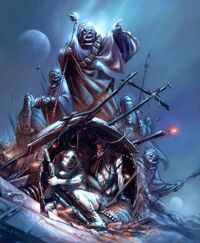
Tusken Raiders attacking a campsite.
According to history as passed down through Storytellers, the evolution of the Tusken Raiders could be traced back to the Kumumgah, a technologically advanced race that once built great cities all over the then lush world of Tatooine. Over millennia, the Kumumgah achieved space travel among the worlds of the Outer Rim and beyond, attracting the attention of the Rakatan Infinite Empire, who conquered, enslaved, and annexed Tatooine. Some time before 25,200 BBY, the Kumumgah rose up against their Rakatan masters, but were punished by orbital bombardment and left for dead. The bombardment slagged the surface of Tatooine into little more than fused glass, which eventually crumbled into desert sand. The Kumumgah, however, had anticipated such an act, and survived by taking refuge in caves across the planet.[1] Over time, they diverged into two separate species, Jawas and Ghorfa.[8]
The Ghorfa spent the next thousands of years as a nomadic society, attempting to come to terms with their new identity.[1] After Tatooine was rediscovered by the Galactic Republic in around 5,000 BBY, early Human settlers were believed to have disrupted the water-supply of a settled cave-dwelling society known as Ghorfa culture, precipitating the transformation of the natives into the Sand People. To survive, they were forced to steal and adapt the technology of the colonists, forging the distinctive desert survival gear by which they would subsequently become so well-known.[source?] By around 4,000 BBY, they were also engaged in endemic low-level warfare with the settlers, raids which were among the factors that forced Czerka Corporation to abandon their attempts to operate Tatooine as a mining world.[1]
Tatooine was, it seems, largely forgotten by the wider galaxy for the next few thousand years, and indeed, the planet apparently had to be formally rediscovered in 1,100 BBY. By the sixth century BBY, however, a mining colony had been reestablished, and the key moment in the history of the Sand People and their relations with the outlanders occurred in around 550 BBY, when they encountered an offworlder and rogue named Alkhara.

Tuskens raiding
Initially, Alkhara was an operative of the colony's Bureau of Ethnology and Socialization, studying the Sand People, and seemingly gaining their trust. Eventually, however, he turned against the colonists and occupied the desert fortress that was used in earlier centuries by the B'omarr Order and in later centuries by Jabba Desilijic Tiure's criminal empire. It is not clear how closely his banditry was connected with his relations with the Sand People, but in the most notorious incident of his career, he allied himself with a group of Sand People whose bivouacs lay on the Great Mesra Plateau to wipe out a police garrison, then afterwards turned on his Sand Person confederates, and destroyed their camp. This, it is claimed, was the source of a subsequent blood feud between the natives and the outlanders.
Permanent settlement by offworlders—or outlanders—only seems to have resumed in 100 BBY, with the arrival of the settler ship Dowager Queen from Bestine IV. A new planetary capital called Bestine was founded, and a second settlement called Fort Tusken was established at the northern tip of the Jundland range. At first, the new colonists seem to have been unaware of the Sand People, but a series of attacks between 98 and 95 BBY forced the abandonment of Fort Tusken, and from that point on, the Human settlers of Tatooine referred to the natives as "Tusken Raiders".
Sometime after Biggs Darklighter left Tatooine, there was a lot of unrest among the Tuskens Raiders. They raided even the outskirts of Anchorhead.[9]
Notable Tusken Raiders
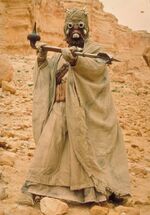
A fierce Tusken Raider leader URoRRuR'R'R attacking Luke Skywalker.
- A'Sharad Hett, a Clone Wars-era Jedi, who later went on to become Darth Krayt, form the new Sith Order and later claim the title of Emperor of the new Galactic Empire (biologically Human, born within a clan)
- A-Zulmun, tribal leader and slayer of Ranon Djelkh
- Grk'kkrs'ar, a mythic fearless Tusken Raider
- Hoar, the only known Tusken to master the ancient art of Teräs Käsi
- Jundland Banshee, a rogue Sand Person
- K'Sheek, a female warrior, mate of Sharad Hett and mother of A'Sharad (biologically Human)
- Orr Agg R'orr, sniped Teemto Pagalies at the Boonta Eve Classic
- RR'uruurrr, attacked Luke Skywalker in the Jundland Wastes
- Raito, known for his ability to hunt and slay Jedi during the Great Sith War era
- Sardu Sallowe, a Tusken bounty hunter who once teamed up with Zuckuss and 4-LOM
- Sand People chieftain, the chieftain of a Sand People tribe who negotiated with Revan.
- Sharad Hett, Galactic Republic-era Jedi, father of A'Sharad (Human, adopted into his clan as an adult)
- Sliven, foster father of Tahiri Veila
- Tahiri Veila, Jedi Knight raised by Sand People (Human, adopted into her clan as a child)
- URoRRuR'R'R, a skilled hunter who captured Luke Skywalker and R2-D2.
- Grave Tuskens, a group of Tuskens on Sulon, one of the few cases of Tusken presence off-Tatooine.
Behind the scenes
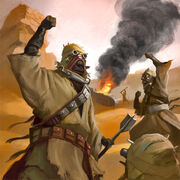
A band of Tusken Raiders.
The Tuskens appeared initially in the second draft of Star Wars: A New Hope, as Imperial spies deployed as a platoon onto the surface of Utapau to search for whatever had brought Deak Starkiller to that planet. They appeared to be humanoid, with red eyes, and drove distinctive landspeeders. They became a native people of Utapau in the third draft.[10]
Sand People fire upon podracers during the Boonta Eve Classic in The Phantom Menace. Humorously enough, they are accurate enough with their fire to actually hit one of the podracers, in spite of Obi-Wan's Episode IV comment, "these blast points... too accurate for Sand People. Only Imperial stormtroopers are so precise" (although stormtroopers are notoriously atrocious shots in the original trilogy (see Stormtrooper effect), but this can be attributed to their rifles). Another take on this is that the blast points on the sandcrawler were specifically on the treads and engines, and since Tuskens have little to no knowledge of the workings of a sandcrawler, they would not know where exactly to shoot it to disable it. Therefore, they are accurate enough to shoot a podracer down, simply because they know to hit the podracer. Had they attacked the sandcrawler, there likely would have been blast points covering the whole sandcrawler, not just the treads.
In the Xbox adventure game Star Wars: Obi-Wan set during and prior to the events of the Star Wars Episode I: The Phantom Menace, Padawan Obi-Wan Kenobi is forced to rescue the Queen of Naboo (or one of her doubles) after she is abducted by Tuskens during the layover on Tatooine. In the game, Kenobi must even stalk through a communal Tusken burial site. As Obi-Wan Kenobi, the player must track the Raiders through their extensive canyon dwellings among old scavenged shipwrecks-turned-fortresses and eventually do battle with a Tusken war chief, who intended to keep the queen as a trophy. A sequence of cultural interest depicts the Tuskens solemnly and ceremoniously conceding defeat after Obi-Wan demands to be allowed to return to safety with the Queen since he has defeated the Tusken war chief.
Grave Tuskens appear in Star Wars: Jedi Knight: Dark Forces II as henchmen to the Dark Jedi Jerec and Maw on the moon of Sulon. This is the only appearance of a Sand People group off Tatooine, although Hoar from Star Wars: Masters of Teräs Käsi did travel offworld to learn that martial art from Arden Lyn. Also, in a panel of Crimson Empire II: Council of Blood, a lone Tusken Raider is seen in the palace of Grappa the Hutt on the planet Genon.

A possible depiction of an unmasked Tusken Raider.
Tuskens also appear in Star Wars: Jedi Knight: Mysteries of the Sith in the Ka'Pa mission. The level vaguely resembles Tatooine, although the game doesn't specify the name of the planet the level takes place.
In the PC game Star Wars: Galactic Battlegrounds and its expansion pack Clone Campaigns, there is a hidden Easter egg in the first Chewbacca campaign; over in the far right corner of the first mission, under the fog of war, is a scene similar to the Obi-Wan mission mentioned above. This can only be accessed by using the cheat codes "forceexplore" and "forcesight," dissipating the fog of war. Success in the mission is lost if the side-mission is failed.
When a Tusken speaks, they sound like the sea lions of Earth, but in actuality their sounds were fashioned by Ben Burtt from donkey brays. The desert survival gear, a form of Sith stalker armor, is very similar to a Tusken raider in appearance.
In Star Wars: Republic 62: No Man's Land, an image is shown of a Tusken without a mask, although this may just be Anakin Skywalker's mental image of the Sand People, rather than an accurate portrayal.

A possible more accurate portrait of an unmasked Tusken Raider.
In the RPG Star Wars: Knights of the Old Republic, one of the side-quests requires that the player infiltrate a Sand People village. Upon doing so, an extremely long history of the Sand People is presented to the player.
Also the game puts forth the theory that perhaps the Ghorfas/Tusken Raiders, along with the Jawas[8] are, in fact, Human, or at least are related to them. During dialogue with the tribe's storyteller in the Sand People's village, if the main character, Revan, asks whether the similarities between those who were taken by the Rakata and the Human colonists are physical or societal, HK-47 will remark, "Cautionary: Master, if you mean to suggest that humanity is ancestrally linked to ancient Tatooine, you will strain his belief system to its pitiful meatbag maximum."
Star Wars: Knights of the Old Republic contains a mistake in the history of the Tusken Raiders. HK-47 refers to the storyteller as "this Raider", but the term Tusken Raider was not invented until almost 4000 years later, since the game's storyline is set in 3,956 BBY. Thus, they ought to be referred to as Sand People. However, this can be excused, since "raider" is simply someone who raids, and Fort Tusken is not mentioned.
Along with Ewoks and Vulptereens, Tusken Raiders are among the species without the mental aptitude necessary to become Jedi.[11]
In the book Darksaber Luke Skywalker states that its impossible to tell Tusken males and females apart, but in Star Wars Episode II: Attack of the Clones, there are clear dress differences between males and females. This mistake can be explained by the fact that the dress differences were not established when Darksaber was published.
Appearances
Non-canon appearances
- LEGO Star Wars: The Video Game
- LEGO Star Wars III: The Clone Wars
- LEGO Star Wars II: The Original Trilogy
- LEGO Star Wars: The Complete Saga
- Star Wars: Battlefront II
- Nobody's Perfect (Mentioned only)
- Star Wars: The Clone Wars: Republic Heroes (Head only)
- Old Wounds (Mentioned only)
- Best Birthday Ever
- Skippy the Jedi Droid
- Choose Your Own Star Wars Adventure: A New Hope
- The Emperor's Court
- Star Wars Infinities: The Empire Strikes Back (Vision to Darth Vader)
- Star Wars: Visions of the Blade
- Star Wars: The Force Unleashed video game — Ultimate Sith Edition
- LEGO Star Wars: The Padawan Menace
Sources
Notes and references
- ↑ 1.0 1.1 1.2 1.3 Star Wars: Knights of the Old Republic
- ↑ Star Wars: Republic 10: Outlander, Part 4
- ↑ Star Wars: Obi-Wan
- ↑ Darksaber
- ↑ Tatooine Ghost
- ↑ The Lost City of Tatooine
- ↑ Darksaber (novel)
- ↑ 8.0 8.1 Star Wars Galaxies - Terminal mission "Jawas Were Spacefarers!" Cite error: Invalid
<ref>tag; name "swgalaxies1" defined multiple times with different content - ↑ Star Wars Episode IV: A New Hope novel
- ↑ The Making of Star Wars: The Definitive Story Behind the Original Film
- ↑ Shouldn't there be a Wookiee Jedi?
External links
 Tusken Raiders on Wikipedia
Tusken Raiders on Wikipedia Tusken Raiders on the SWG Wiki
Tusken Raiders on the SWG Wiki- Star Wars Sand People Under the Tusken Sun
- Tusken Raiders on the Family Guy Wiki
- Template:SWSB

